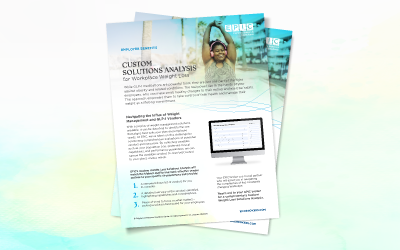The workplace environment and employee benefits play no small part in an employee’s health and wellbeing.
In fact, employers have the potential to play a significant role in offering their population resources and assistance to manage—and even improve—their mental, physical, financial, and emotional wellbeing.
EPIC Brokers recently conducted a research study of employers to delve into their experience beyond health insurance—to understand how wellness programs are being leveraged. Read on for key findings of the survey in our recently published 2023 Trends in Workplace Wellness report.
Our Trends Report shows that most employers believe wellness in the workplace is a medium or high priority, with only one out of ten reporting wellness as a low priority. Employers who are paying attention know that happy, healthy employees make productive team members and contribute to an overall positive environment.
Population health and wellbeing is an important topic that’s here to stay and will continue to evolve over the next few years as more data becomes available to show which programs and rewards are most effective at moving employees toward wellness. In the current state, while many employers are seeking greater participation and stronger outcomes, they are confused about making the smartest strategic decisions as it relates to wellness initiatives.
Social Determinants of Health (SDoH) can help employers better understand what lies at the root of employees’ overall health.
If you haven’t heard about them yet, you will hear more about Social Determinants of Health (SDoH) in the coming years among the healthcare community. Employers are seeking to get to the root cause of wellness and disease. SDoH are the non-medical factors that impact an individual’s health or pursuit of health.
Examples of SDoH include economic stability, level of education, access to healthcare, neighborhood environment, and social and community context. This includes family dynamics and adverse childhood experiences, which can have a significant and long-lasting impact on a person’s overall health.
In our trends survey, we learned that 87% of the employers that responded were either unsure about whether or not SDoH factors are currently being used (49%) or are not using SDoH as part of their overall wellbeing strategy (38%). There is a lot of work to do.
SDoH can impact certain communities more negatively than others. For example, experts have linked low socioeconomic status with:
- Higher probabilities of obesity, heart disease, and diabetes
- Lower life expectancy
- Higher occurrences of preventable disease
- Delayed recognition and treatment of disease
- Difficulty navigating the healthcare system and following self-care routines
- Increased likelihood of receiving medical treatment in more expensive, less effective settings
Employers should assess their total rewards planning, benefits, and wellness programs with SDoH in mind. Consider ways to collect more data through health risk assessments, employee surveys, payroll HRIS data, claims data, and data provided by health plan carriers. Your EPIC broker can help you turn that data into actionable information.
Solutions to Address SDoH
Workplace wellbeing programs have room for improvement. While our survey identified wellness as a priority for most organizations, for many of our survey respondents, the participation rate was suboptimal. About three out of every four programs have a participation rate of 50% or lower, and more than half of respondents feel neutral or dissatisfied with their current program.
Making a wellness program relevant to your population—often through identifying and responding to specific SDoH needs—is one way to create that engagement and participation. When wellness initiatives are seen as a valuable resource, employees are likely to pay attention.
Economic Stability
Wellness programs and financial incentives to maintain healthy lifestyle habits (e.g., subsidized vouchers for healthy food, gift cards, gym memberships, reduced medical contributions)
Education
Encourage health literacy by facilitating educational sessions for nutrition, physical activity, self-care, and healthcare.
Health & Healthcare
Offer regional carrier and health plan learning sessions. Coordinate with local health organizations to provide free training and resources for your team.
Neighborhood & Built Environment
Coordinate with local health and community organizations to provide resources to support the employees outside of the workplace.
Social & Community Context
Create a safe, collaborative, and supportive workplace that provides resources for mental, physical, financial, and emotional wellbeing.
To learn more about other trends in workplace wellness, and see how your program compares, download EPIC’s 2023 Trends in Workplace Wellness Report.
Fill out this form to download your copy of the 2023 Trends in Workplace Wellness Report.
“*” indicates required fields
Related Content
Products
Employee Benefits Consulting
Our dedicated EPIC benefits team is focused on delivering better outcomes – to both your benefits program ...
Products
Wellbeing & Health Management
Our Wellbeing and Health Management consultants help you create a strategy around population health ...
Products
Pharmacy Solutions
Our pharmacy experts work with the health and welfare teams to deliver certainty and direction for your ...



